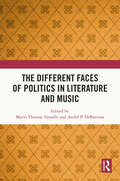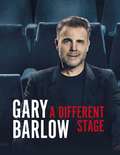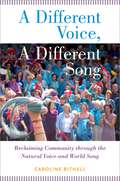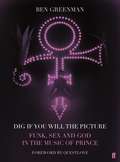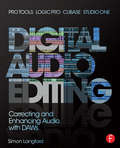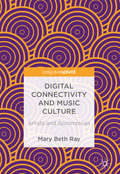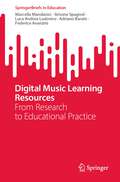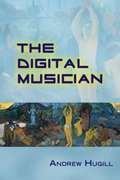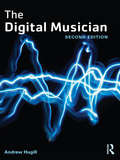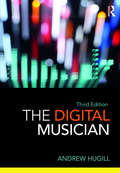- Table View
- List View
Difference and Division in Music Education (ISME Series in Music Education)
by Alexis Anja KallioDifference and Division in Music Education enriches existing diversity and social justice discourses by considering the responsibility of music education to respond to rising social discord and tensions. Although ‘hate’ is by no means a new concern for policymakers, educators, or musicians, the climate of fast communications, divisive politics, and intensified encounters with ‘difference’ has framed expressions of hate as a rising social problem to which we cannot afford complacency. This edited volume of ten contributed essays approaches ‘hate’ not as a monstrous aberration, but as a product of late modernity entangled within the complex power-relations that frame both governance and agency at the policy, institutional, and interpersonal levels. Schools, universities, and community organisations have been positioned on the front lines of addressing ‘hate’ and cultivating a healthy society. In recognising that music education is always both inclusive and exclusive, this volume interrogates the social norms and values that comprise the ‘common good’ and simultaneously cast certain musics, expressions, individuals, or social groups as different, divisive, hateful, or hated. Difference and Division in Music Education highlights the ethical and political dimensions of teaching and learning music across a number of geographical, cultural, and educational contexts and through a rich variety of perspectives.
Difference and Division in Music Education (ISME Series in Music Education)
by Alexis Anja KallioDifference and Division in Music Education enriches existing diversity and social justice discourses by considering the responsibility of music education to respond to rising social discord and tensions. Although ‘hate’ is by no means a new concern for policymakers, educators, or musicians, the climate of fast communications, divisive politics, and intensified encounters with ‘difference’ has framed expressions of hate as a rising social problem to which we cannot afford complacency. This edited volume of ten contributed essays approaches ‘hate’ not as a monstrous aberration, but as a product of late modernity entangled within the complex power-relations that frame both governance and agency at the policy, institutional, and interpersonal levels. Schools, universities, and community organisations have been positioned on the front lines of addressing ‘hate’ and cultivating a healthy society. In recognising that music education is always both inclusive and exclusive, this volume interrogates the social norms and values that comprise the ‘common good’ and simultaneously cast certain musics, expressions, individuals, or social groups as different, divisive, hateful, or hated. Difference and Division in Music Education highlights the ethical and political dimensions of teaching and learning music across a number of geographical, cultural, and educational contexts and through a rich variety of perspectives.
The Different Faces of Politics in Literature and Music
by Mario Thomas Vassallo André P. DeBattistaThis book highlights the links between politics and governance and the arts. The essays in the volume show how literature and music have challenged those in power risking political censure. In addition, they also try to delineate how patronage has been used for propaganda, or to stir up national fervour. They focus on the tension and symbiosis between the politician and the artist foregrounding how they have always tried to influence, challenge, and, in some cases, undermine one another. This volume will serve as an indispensable source for researchers and academics in political science, the humanities and performing arts.
The Different Faces of Politics in Literature and Music
by Mario Thomas Vassallo Andre P. DeBattistaThis book highlights the links between politics and governance and the arts. The essays in the volume show how literature and music have challenged those in power risking political censure. In addition, they also try to delineate how patronage has been used for propaganda, or to stir up national fervour. They focus on the tension and symbiosis between the politician and the artist foregrounding how they have always tried to influence, challenge, and, in some cases, undermine one another. This volume will serve as an indispensable source for researchers and academics in political science, the humanities and performing arts.
A Different Paradigm in Music Education: Re-examining the Profession (Routledge New Directions in Music Education Series)
by David A WilliamsA Different Paradigm in Music Education is a "let’s consider some possibilities" book. Instead of a music methods book, it is a look at where the music education profession is and how music teachers might improve what it is we do. It is about change. It is about questioning the current music education paradigm, especially regarding its exclusive role as the only model. The intent is to help pre-service and in-service music educators consider new modes of pedagogical thought that will allow us to broaden our reach in schools and better help students develop as creative musicians across their lifespan. The book includes an overview of several opportunities and course examples that would make music education more relevant and meaningful, especially for students that are not interested in our traditional performance offerings. The author wishes to stimulate discussions, with the goal for the music education profession to grow and mature.
A Different Paradigm in Music Education: Re-examining the Profession (Routledge New Directions in Music Education Series)
by David A WilliamsA Different Paradigm in Music Education is a "let’s consider some possibilities" book. Instead of a music methods book, it is a look at where the music education profession is and how music teachers might improve what it is we do. It is about change. It is about questioning the current music education paradigm, especially regarding its exclusive role as the only model. The intent is to help pre-service and in-service music educators consider new modes of pedagogical thought that will allow us to broaden our reach in schools and better help students develop as creative musicians across their lifespan. The book includes an overview of several opportunities and course examples that would make music education more relevant and meaningful, especially for students that are not interested in our traditional performance offerings. The author wishes to stimulate discussions, with the goal for the music education profession to grow and mature.
A Different Stage: The remarkable and intimate life story of Gary Barlow told through music
by Gary BarlowJoin national treasure Gary Barlow as he opens the curtains on his remarkable life in this stunning autobiography, from his fascinating early life to his star-studded music career'I just wanted to share my personal journey through the last five decades - the highs and lows, the ups and downs. So in A Different Stage, this is me opening the curtains and sharing moments nobody has heard or seen before . . .'__________In this warm, intimate and humorous book, rich with nostalgia and unexpected intimate detail, Gary Barlow unpacks the people, music, places, things and cultural phenomena that have made him the man that he is.From the working men's club where it all began through to the sold out stadium tours, this is the story of Gary's life told through music. Filled with a mixture of brand new photography from Gary's current one-man show and incredibly personal unseen photos and notebooks, A Different Stage is a beautiful book about the man we've spent our lives listening to.
A Different Voice, A Different Song: Reclaiming Community through the Natural Voice and World Song
by Caroline BithellA Different Voice, A Different Song traces the history of a grassroots scene that has until now operated largely beneath the radar, but that has been gently gathering force since the 1970s. At the core of this scene today are the natural voice movement, founded on the premise that "everyone can sing", and a growing transnational community of amateur singers participating in multicultural music activity. Author Caroline Bithell reveals the intriguing web of circumstances and motivations that link these two trends, highlighting their potential with respect to current social, political and educational agendas. She investigates how and why songs from the world's oral traditions have provided the linchpin for the natural voice movement, revealing how the musical traditions of other cultures not only provide a colourful repertory but also inform the ideological, methodological and ethical principles on which the movement itself is founded. A Different Voice, A Different Song draws on long-term ethnographic research, including participant-observation at choir rehearsals, performances, workshops and camps, as well as interviews with voice teachers, choir and workshop leaders, camp and festival organisers, and general participants. Bithell shows how amateur singers who are not musically literate can become competent participants in a vibrant musical community and, in the process, find their voice metaphorically as well as literally. She then follows some of these singers as they journey to distant locations to learn new songs in their natural habitat. She theorises these trends in terms of the politics of participation, the transformative potential of performance, building social capital, the global village, and reclaiming the arts of celebration and conviviality. The stories that emerge reveal a nuanced web of intersections between the local and global, one which demands a revision of the dominant discourses of authenticity, cultural appropriation and agency in the post-colonial world, and ultimately points towards a more progressive politics of difference. A Different Voice, a Different Song will be an essential text for practitioners involved in the natural voice movement and other vocal methodologies and choral worlds. As a significant study in the fields of ethnomusicology, music education and community music, the book will also be of interest to scholars studying the democratisation of the voice, the dynamics of participation, world musics in performance, the transformative power of harmony singing, and the potential of music-making for sustaining community and aiding intercultural understanding.
Dig: Sound and Music in Hip Culture
by Phil FordHipness has been an indelible part of America's intellectual and cultural landscape since the 1940s. But the question What is hip? remains a kind of cultural koan, equally intriguing and elusive. In Dig, Phil Ford argues that while hipsters have always used clothing, hairstyle, gesture, and slang to mark their distance from consensus culture, music has consistently been the primary means of resistance, the royal road to hip. Hipness suggests a particular kind of alienation from society--alienation due not to any specific political wrong but to something more radical, a clash of perception and consciousness. From the vantage of hipness, the dominant culture constitutes a system bent on excluding creativity, self-awareness, and self-expression. The hipster's project is thus to define himself against this system, to resist being stamped in its uniform, squarish mold. Ford explores radio shows, films, novels, poems, essays, jokes, and political manifestos, but argues that music more than any other form of expression has shaped the alienated hipster's identity. Indeed, for many avant-garde subcultures music is their raison d'être. Hip intellectuals conceived of sound itself as a way of challenging meaning--that which is cognitive and abstract, timeless and placeless--with experience--that which is embodied, concrete and anchored in place and time. Through Charlie Parker's "Ornithology," Ken Nordine's "Sound Museum," Bob Dylan's "Ballad of a Thin Man," and a range of other illuminating examples, Ford shows why and how music came to be at the center of hipness. Shedding new light on an enigmatic concept, Dig is essential reading for students and scholars of popular music and culture, as well as anyone fascinated by the counterculture movement of the mid-twentieth-century. Publication of this book was supported by the AMS 75 PAYS Endowment of the American Musicological Society, funded in part by the National Endowment for the Humanities and the Andrew W. Mellon Foundation.
Dig: Sound and Music in Hip Culture
by Phil FordHipness has been an indelible part of America's intellectual and cultural landscape since the 1940s. But the question What is hip? remains a kind of cultural koan, equally intriguing and elusive. In Dig, Phil Ford argues that while hipsters have always used clothing, hairstyle, gesture, and slang to mark their distance from consensus culture, music has consistently been the primary means of resistance, the royal road to hip. Hipness suggests a particular kind of alienation from society--alienation due not to any specific political wrong but to something more radical, a clash of perception and consciousness. From the vantage of hipness, the dominant culture constitutes a system bent on excluding creativity, self-awareness, and self-expression. The hipster's project is thus to define himself against this system, to resist being stamped in its uniform, squarish mold. Ford explores radio shows, films, novels, poems, essays, jokes, and political manifestos, but argues that music more than any other form of expression has shaped the alienated hipster's identity. Indeed, for many avant-garde subcultures music is their raison d'être. Hip intellectuals conceived of sound itself as a way of challenging meaning--that which is cognitive and abstract, timeless and placeless--with experience--that which is embodied, concrete and anchored in place and time. Through Charlie Parker's "Ornithology," Ken Nordine's "Sound Museum," Bob Dylan's "Ballad of a Thin Man," and a range of other illuminating examples, Ford shows why and how music came to be at the center of hipness. Shedding new light on an enigmatic concept, Dig is essential reading for students and scholars of popular music and culture, as well as anyone fascinated by the counterculture movement of the mid-twentieth-century. Publication of this book was supported by the AMS 75 PAYS Endowment of the American Musicological Society, funded in part by the National Endowment for the Humanities and the Andrew W. Mellon Foundation.
Dig If You Will The Picture: Funk, Sex and God in the Music of Prince
by Ben GreenmanBen Greenman's monumental yet intimate book on Prince comes a year after the star's death at the age of 57 in an elevator at the legendary Paisley Park complex. With the release of a string of critically acclaimed albums and a new solo tour, the Minneapolis Genius looked set for a renaissance after a quiet-ish (by his standards) decade or so. And then: the silence, forever. Dig If U Will The Picture is a portrait of The Artist, who was also the artist who will be remembered by many as the brightest, most seductive and enigmatic pop star of his generation. In thematically structured chapters, Ben Greenman anatomizes a career and an aesthetic that at times seemed otherworldly. Drawing on over 40 studio albums, a repertoire of 2,000 plus live shows and close analysis of the unreleased highlights of the Vault, Dig If U Will the Picture is a critical consideration of Prince's art, a testimony to the author's deep and abiding personal connection to the work, and a fitting memorial.
Digital Audio Editing: Correcting and Enhancing Audio in Pro Tools, Logic Pro, Cubase, and Studio One
by Simon LangfordWhether you’re comping a vocal track, restoring an old recording, working with dialogue or sound effects for film, or imposing your own vision with mash-ups or remixes, audio editing is a key skill to successful sound production. Digital Audio Editing gives you the techniques, from the simplest corrective editing like cutting, copying, and pasting to more complex creative editing, such as beat mapping and time-stretching. You’ll be able to avoid unnatural-sounding pitch correction and understand the potential pitfalls you face when restoring classic tracks. Author Simon Langford invites you to see editing with his wide-angle view, putting this skill into a broad context that will inform your choices even as you more skillfully manipulate sound. Focusing on techniques applicable to any digital audio workstation, it includes break-outs giving specific keystrokes and instruction in Avid’s Pro Tools, Apple’s Logic Pro, Steinberg’s Cubase, and PreSonus’s Studio One. The companion websites includes tutorials in all four software packages to help you immediately apply the broad skills from the book.
Digital Audio Editing: Correcting and Enhancing Audio in Pro Tools, Logic Pro, Cubase, and Studio One
by Simon LangfordWhether you’re comping a vocal track, restoring an old recording, working with dialogue or sound effects for film, or imposing your own vision with mash-ups or remixes, audio editing is a key skill to successful sound production. Digital Audio Editing gives you the techniques, from the simplest corrective editing like cutting, copying, and pasting to more complex creative editing, such as beat mapping and time-stretching. You’ll be able to avoid unnatural-sounding pitch correction and understand the potential pitfalls you face when restoring classic tracks. Author Simon Langford invites you to see editing with his wide-angle view, putting this skill into a broad context that will inform your choices even as you more skillfully manipulate sound. Focusing on techniques applicable to any digital audio workstation, it includes break-outs giving specific keystrokes and instruction in Avid’s Pro Tools, Apple’s Logic Pro, Steinberg’s Cubase, and PreSonus’s Studio One. The companion websites includes tutorials in all four software packages to help you immediately apply the broad skills from the book.
Digital Connectivity and Music Culture: Artists and Accomplices
by Mary Beth RayThis book explores how the rise of widely available digital technology impacts the way music is produced, distributed, promoted, and consumed, with a specific focus on the changing relationship between artists and audiences. Through in-depth interviewing, focus group interviewing, and discourse analysis, this study demonstrates how digital technology has created a closer, more collaborative, fluid, and multidimensional relationship between artist and audience. Artists and audiences are simultaneously engaged with music through technology—and technology through music—while negotiating personal and social aspects of their musical lives. In light of consistent, active engagement, rising co-production, and collaborative community experience, this book argues we might do better to think of the audience as accomplices to the artist.
Digital Connectivity and Music Culture: Artists and Accomplices (PDF)
by Mary Beth RayThis book explores how the rise of widely available digital technology impacts the way music is produced, distributed, promoted, and consumed, with a specific focus on the changing relationship between artists and audiences. Through in-depth interviewing, focus group interviewing, and discourse analysis, this study demonstrates how digital technology has created a closer, more collaborative, fluid, and multidimensional relationship between artist and audience. Artists and audiences are simultaneously engaged with music through technology—and technology through music—while negotiating personal and social aspects of their musical lives. In light of consistent, active engagement, rising co-production, and collaborative community experience, this book argues we might do better to think of the audience as accomplices to the artist.
Digital Electronics for Musicians
by Alexandros DrymonitisThis is the perfect book for musicians who want to dive into the world of computer music and physical computing. This book is aimed at adventurous musicians who want to learn about music programming with Arduino, sensors, and Pure Data, and how to make new interfaces and even new instruments with that knowledge. You’ll learn the basics of the Pure Data and Arduino languages, how to incorporate sensors into your musical projects, and how to use embedded computers, like the Raspberry Pi, to create stand-alone projects. Along the way, you’ll learn how to create a variety of innovative musical projects, including an interactive bow for stringed instruments, a MIDI clavier synthesizer, an interactive drum set, a patch-bay matrix synthesizer, a guitar looper, and even a DIY theremin. If you are a musician or tinkerer who wants to explore the world of electronic and electroacoustic music and musical interfaces with Arduino, sensors, and Pure Data, Digital Electronics for Musicians is the book for you. What You Will LearnLearn the basics of the Pure Data and the Arduino languagesLearn more about the available sensors on the market, and how you can incorporate them into your musical projectsFocus on physical computing by combining Arduino and Pure Data, bringing the physical world to the world of the computersMake use of additional libraries that extend the capabilities of the ArduinoMake use of external objects in Pure Data that help achieve certain goals, depending on the projectLearn how a Pure Data patch functions and be able to modify other people's work that fits your needsLearn how the Arduino language works, enabling the modification of already existing code, according to your needsGet insight on the serial communication between the Arduino and Pure DataLearn how to approach various programming challenges in different waysWho This is For Musicians who want to explore the world of electronic and electroacoustic music and musical interfaces with Arduino, sensors, and Pure Data.
Digital Electronics for Musicians: Build Intuitive Electronics and Electroacoustic Music Interfaces (Maker Innovations Series)
by Alexandros DrymonitisDive into the world of computer music and physical computing and stay ahead of the melodic curve. This book is aimed at adventurous musicians who want to learn about music programming with Arduino, sensors, and Pure Data, and how to make new interfaces and instruments with that knowledge. In this updated version, you can expect a wave of updates that bring the content in sync with the latest tech trends. The book now features revamped code and visuals throughout, all tailored to match the cutting-edge versions of Pure Data, Arduino IDE, and the powerful Raspberry Pi 5. What's even more thrilling is the integration of the Bela platform for audio enthusiasts, alongside an expanded wireless toolkit that includes both Wi-Fi and the trusty XBee. To ensure a smoother journey, there are more project-enhancing images to guide you, and a brand-new chapter dedicated to AI, based on the author's innovative neuralnet object for Pure Data, as showcased in the AIMC conference proceedings. You’ll start with the basics of the Pure Data and Arduino languages, how to incorporate sensors into your musical projects, and how to use embedded computers, like the Raspberry Pi, to create stand-alone projects. Along the way, you’ll learn how to create a variety of innovative musical projects, including an interactive glove that can be used bystringed instrumentalists or other musicians, an interactive drum set, a patch-bay matrix synthesizer, a guitar looper, a DIY theremin, and even DIY instruments that incorporate AI. If you are a musician or tinkerer who wants to explore the world of electronic and electroacoustic music, then Digital Electronics for Musicians, Second Edition is the book for you. What You Will Learn Incorporate sensors into your musical projects. Combine Arduino and Pure Data to bring the physical world to computers. Use additional libraries that extend the capabilities of the Arduino. Work with external objects in Pure Data and create your own patches from scratch. Write your own sketches with Arduino. Who This Book Is For Musicians who want to explore the world of electronic and electroacoustic music.
Digital Flows: Online Hip Hop Music and Culture
by Steven GambleThis is an open access title available under the terms of a CC BY-NC-ND 4.0 International licence. It is free to read on the Oxford Academic platform and offered as a free PDF download from OUP and selected open access locations. Some fifty years after its birth in the Bronx, hip hop has become one of the most influential cultural phenomena of the internet era. With the internet now enmeshed in our daily routines, hip hop thrives in the digital realm, constituting a third of all music streams. From Drake memes to viral TikTok dances and AI-generated rappers, hip hop is constantly created, shared, and discussed online. This shift challenges hip hop's conventional connections to place, authenticity, and community. Through this book, author Steven Gamble offers a fresh examination of hip hop's latest chapter, intricately interwoven with the interconnected cultural currents of the internet. With an innovative method encompassing music and cultural analysis, ethnography, and web data analysis, Gamble provides a cutting-edge account of the intersections between hip hop and the internet, supported by the latest practices in digital humanities and data ethics. The book extensively draws on scholarship in hip hop studies, internet studies, popular music studies, media studies, communication studies, cultural studies, Black studies, intersectional feminism, and more. Gamble provides in-depth insights into hip hop in the internet age, new net-native genres like Soundcloud rap and YouTube lofi beats, communities on social media and streaming platforms, online hip hop feminism in rap music videos, cultural appropriation and callout/cancel culture, and hip hop concerts on video game platforms. For old school heads and extremely online memesters alike, for fans and creatives, for students as well as academics seeking to understand digital transformations of music, Digital Flows uncovers what happens when a cultural form born on the streets thrives on the transformative technologies of global reach.
Digital Flows: Online Hip Hop Music and Culture
by Steven GambleThis is an open access title available under the terms of a CC BY-NC-ND 4.0 International licence. It is free to read on the Oxford Academic platform and offered as a free PDF download from OUP and selected open access locations. Some fifty years after its birth in the Bronx, hip hop has become one of the most influential cultural phenomena of the internet era. With the internet now enmeshed in our daily routines, hip hop thrives in the digital realm, constituting a third of all music streams. From Drake memes to viral TikTok dances and AI-generated rappers, hip hop is constantly created, shared, and discussed online. This shift challenges hip hop's conventional connections to place, authenticity, and community. Through this book, author Steven Gamble offers a fresh examination of hip hop's latest chapter, intricately interwoven with the interconnected cultural currents of the internet. With an innovative method encompassing music and cultural analysis, ethnography, and web data analysis, Gamble provides a cutting-edge account of the intersections between hip hop and the internet, supported by the latest practices in digital humanities and data ethics. The book extensively draws on scholarship in hip hop studies, internet studies, popular music studies, media studies, communication studies, cultural studies, Black studies, intersectional feminism, and more. Gamble provides in-depth insights into hip hop in the internet age, new net-native genres like Soundcloud rap and YouTube lofi beats, communities on social media and streaming platforms, online hip hop feminism in rap music videos, cultural appropriation and callout/cancel culture, and hip hop concerts on video game platforms. For old school heads and extremely online memesters alike, for fans and creatives, for students as well as academics seeking to understand digital transformations of music, Digital Flows uncovers what happens when a cultural form born on the streets thrives on the transformative technologies of global reach.
Digital Music Learning Resources: From Research to Educational Practice (SpringerBriefs in Education)
by Marcella Mandanici Simone Spagnol Luca Andrea Ludovico Adriano Baratè Federico AvanziniThis book offers an overview of the complex world of digital materials for music education and of their possible use in the everyday practice of music teachers. It presents a multidimensional taxonomy of digital materials for music education. Through the taxonomy it is possible to derive a clear framework of the whole field and to perform analysis of the state of art. The book shows the use of this flexible and powerful knowledge tool for reviewing the digital materials in the various domains and dimentions. The book provides researchers and designers with an overview of what has already been designed, proposed and tested in the field. It also offers music teachers a wider perspective of the possibilities connected to current technologies in the field of music education, and it suggests possible interrelationships between research and music education practices.
The Digital Musician: Creating Music With Digital Technology
by Andrew HugillThe Digital Musician examines cultural awareness, artistic identity and musical skill through the prism of recent technological innovations. New technologies, and especially the new digital technologies, mean that anyone can create music without any musical training. How do we know what is good? This involves developing a personal aesthetic, an awareness of the context for one s work, specific musical and technical abilities and an individual identity. "
The Digital Musician
by Andrew HugillThe Digital Musician is a textbook for creative music technology and electronic music courses. It provides an overview of sound properties, acoustics, digital music, and sound design as a basis for understanding the compositional possibilities that new music technologies allow. Creative projects allow students to apply key concepts covered in each chapter. Topics covered include hardware hacking, live coding, interactive music, sound manipulation and transformation, software instruments, networked performance, as well as critical listening and analysis. Features Readers Guides outline the major topics in each chapter Project boxes for both individuals and groups throughout each chapter Annotated Listening Lists for each chapter, with accompanying playlists on the companion website Recommended Further Reading and Discussion Questions at the end of each chapter Case studies of actual composers, with contributed projects Companion website includes reading lists, links to audio and video, and slides for use in the classroom.
The Digital Musician
by Andrew HugillThe Digital Musician is a textbook for creative music technology and electronic music courses. It provides an overview of sound properties, acoustics, digital music, and sound design as a basis for understanding the compositional possibilities that new music technologies allow. Creative projects allow students to apply key concepts covered in each chapter. Topics covered include hardware hacking, live coding, interactive music, sound manipulation and transformation, software instruments, networked performance, as well as critical listening and analysis. Features Readers Guides outline the major topics in each chapter Project boxes for both individuals and groups throughout each chapter Annotated Listening Lists for each chapter, with accompanying playlists on the companion website Recommended Further Reading and Discussion Questions at the end of each chapter Case studies of actual composers, with contributed projects Companion website includes reading lists, links to audio and video, and slides for use in the classroom.
The Digital Musician
by Andrew HugillThe Digital Musician, Third Edition is an introductory textbook for creative music technology and electronic music courses. Written to be accessible to students from any musical background, this book examines cultural awareness, artistic identity and musical skills, offering a system-agnostic survey of digital music creation. Each chapter presents creative projects that reinforce concepts, as well as case studies of real musicians and discussion questions for further reflection. This third edition has been updated to reflect developments in an ever-changing musical landscape—most notably the proliferation of mobile technologies—covering topics such as collaborative composition, virtual reality, data sonification and digital scores, while encouraging readers to adapt to continuous technological changes. With an emphasis on discovering one’s musical voice and identity, and tools and ideas that are relevant in any musical situation, The Digital Musician is sure to be an invaluable student resource for years to come. Features of the third edition: Additional case studies, with new interviews exclusive to the third edition Revised chapter structure with an emphasis on student focus and understanding, featuring additional and expanded chapters Reinstatement of selected and updated first edition topics, including mixing, mastering and microphones Companion website featuring case study interviews, a historical listening list, bibliography and many additional projects
The Digital Musician
by Andrew HugillThe Digital Musician, Third Edition is an introductory textbook for creative music technology and electronic music courses. Written to be accessible to students from any musical background, this book examines cultural awareness, artistic identity and musical skills, offering a system-agnostic survey of digital music creation. Each chapter presents creative projects that reinforce concepts, as well as case studies of real musicians and discussion questions for further reflection. This third edition has been updated to reflect developments in an ever-changing musical landscape—most notably the proliferation of mobile technologies—covering topics such as collaborative composition, virtual reality, data sonification and digital scores, while encouraging readers to adapt to continuous technological changes. With an emphasis on discovering one’s musical voice and identity, and tools and ideas that are relevant in any musical situation, The Digital Musician is sure to be an invaluable student resource for years to come. Features of the third edition: Additional case studies, with new interviews exclusive to the third edition Revised chapter structure with an emphasis on student focus and understanding, featuring additional and expanded chapters Reinstatement of selected and updated first edition topics, including mixing, mastering and microphones Companion website featuring case study interviews, a historical listening list, bibliography and many additional projects Visit the companion website: www.andrewhugill.com/thedigitalmusician

